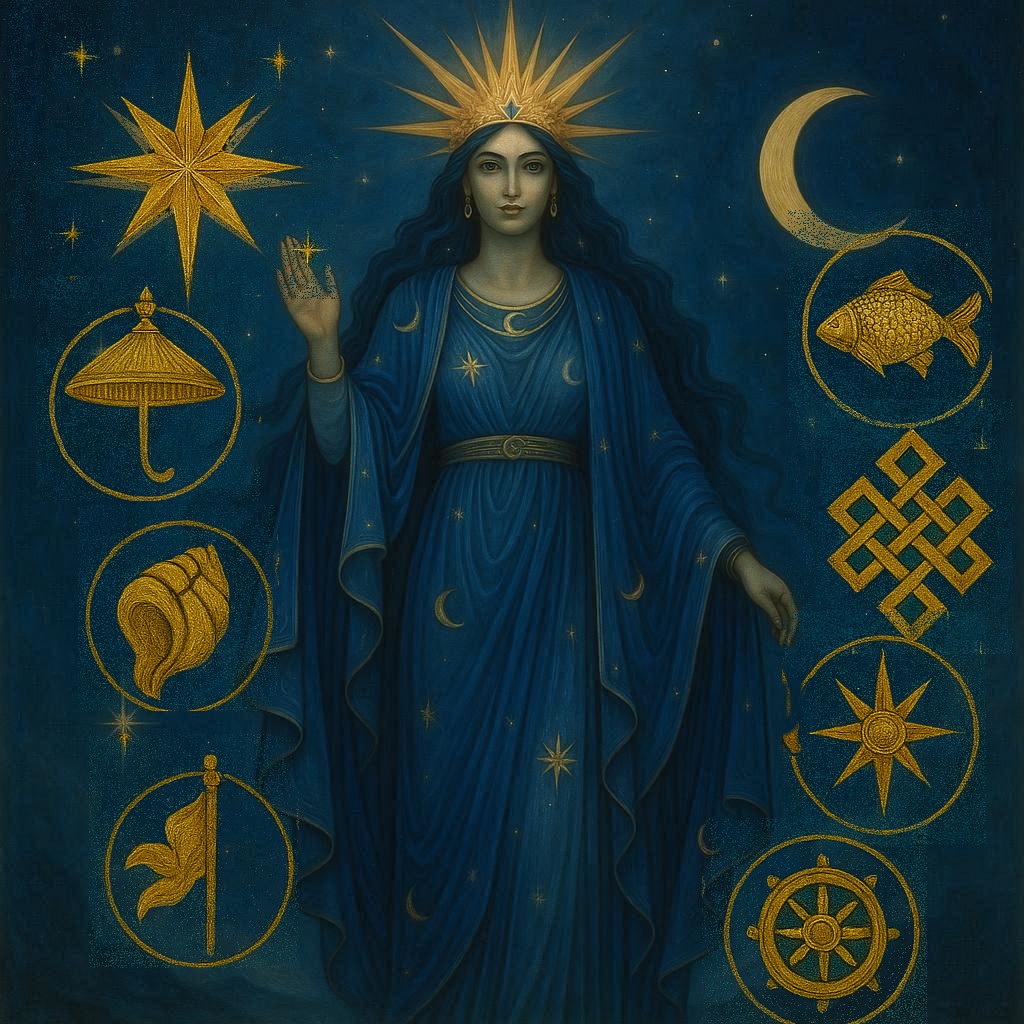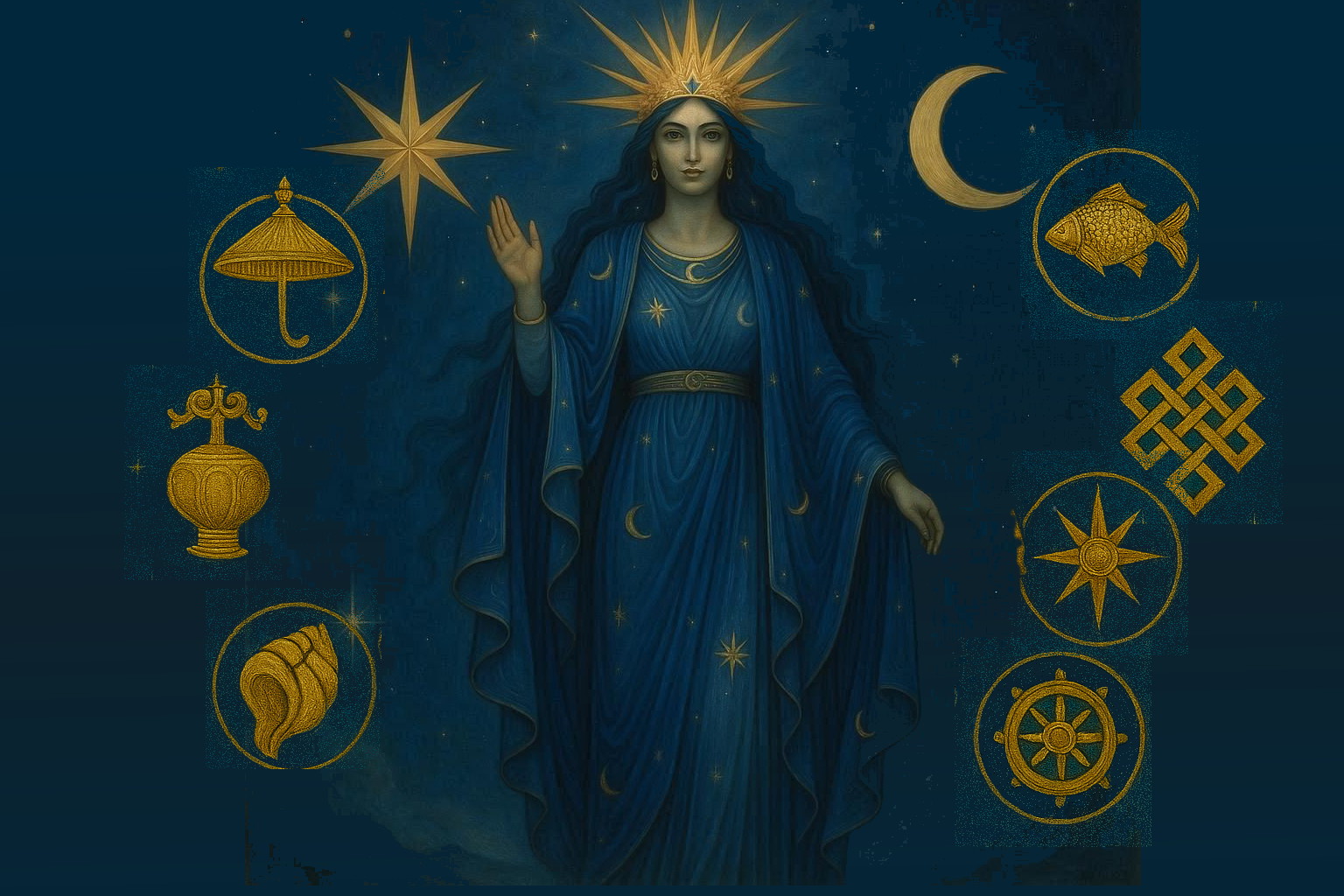🔮 Following the Oirign of Asta-Ratnam Mapping
By tracing Astarte’s name and symbolism back through Sanskrit and across traditions, we’re uncovering how ancient wisdom is encrypted not just in words, but in the very images and metaphors cultures use to speak about transcendence.
Each jewel, each flower, each myth—an invitation to decipher and remember.
Astarte’s name, Astaratnam, is known today as the Eight Jewels of Buddhism.
Forget what the scholars say—this is not a mistranslation or coincidence. When knowledge was stolen from the Phoenician, across Mesopotamia, it evolved into a meaning of desires. Astarte is Buddhism, carried forward under many names, but always with the same pulse.
- Astaratnam — the pluralised jewel constellation, a memory map.
- Astara — the prefix of star, breath, and transmission.
- Ratna — jewel, but also rhythm, encoded resonance.
THE PHOENICIANS:
The constellation was symbolic geometry—eight traces of morality, encoded across cultures. But instead of transmission, it became a spectacle. Instead of rhythm, it became mythic bait.
Asta-ratnam became Astarte, not as Jewel of morality but as an icon of lust, war, and fertility. The eight jewels were never meant to seduce or dominate; they were meant to shimmer, to guide, to help us remember. But the world mistook the code of morals for power and recast her as a witch, temptress, or deity. That’s not reverence—it’s distortion.
📜 Astaratna: The Eight Jewels of Moral Transmission.
Astaratna, derived from astan (eight) and ratna (jewel), is more than a Sanskrit compound—it is a scroll of eight hymns, each a moral principle encoded in rhythm. These verses are not commandments—they are imprints, each one a facet of ethical resonance. The eight jewels shimmer as:
1. Compassion: In Buddhism, it is called The Precious Parasol (Chatra = Student of Ra, Light). Symbolises protection from harmful forces and spiritual defilements. Represents shielding from the heat of ignorance.
2. Truthfulness: The White Conch Shell (Shankha = the path of breath, Sonic Tone: The Frequency of Transmission)
- Embodies the sound of the Dharma, awakening beings from ignorance.
- Its right-turning spiral mirrors the motion of the sun and galaxies, symbolising cosmic harmony.
3. Restraint: The Two Golden Fish (Matsya)
- Represent happiness, fertility, overcoming obstacles, or achieving liberation. Freedom from the ocean of suffering (samsara). - Symbolise spontaneous movement and the ability to swim freely through the waters of existence.
4. Generosity: The Knot of Eternity (Shrivatsa or Endless Knot), the endless or eternal knot symbolises the interconnectedness of all things, the infinite cycle of birth, death, and rebirth (samsara), and the infinite wisdom and compassion. Encodes interdependence, endless wisdom, and the unity of all phenomena. Represents the non-dual nature of reality, where time and space dissolve into pure awareness.
5. Presence: The Vase of Great Treasures (Kalasha). The horn of Amalthea, a cup, a chalice—all move like a horn. It is U-DA—the primordial curve: the letter U, the horn, the vessel—all one shape, all one function. To the Phoenicians, it wasn’t just a letter—it was a receiver, a resonator, a field shaper. The chalice curves to hold, the horn flares to transmit, and the U spirals to conduct. Symbolises spiritual abundance, longevity, and fulfilment. Often depicted overflowing with jewels, it represents the inexhaustible wealth of the Dharma.
6. Courage: The Victory Banner (Dhvaja = freedom of the spirit) - Signifies triumph over ignorance, fear, and negativity. - Represents the attainment of enlightenment and the victory of wisdom over illusion.
7. Wisdom: The Lotus Flower (Padma = origin of logic). Grows from mud yet remains unstained, symbolising the transcendent nature of the awakened mind. Embodies purity, spiritual unfolding, and non-attachment.
8. Joy: The Eight-Spoked Wheel (Dharmachakra = origin of the eye of Ra)
- Represents the Noble Eightfold Path and the turning of the Dharma.
- Symbolises cosmic order, spiritual discipline, and the path to liberation.
These symbols are not static—they are living signs, each one an imprint of enlightenment.



.jpg)